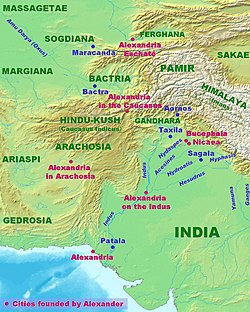Nicaea, Punjab
Nicaea or Nikaia (Ancient Greek: Νίκαια)[1][2] was a city in what is now the Punjab, one of the two cities founded by Alexander the Great on opposite sides of the Hydaspes river. The second city founded by Alexander on the Hydaspes was Bucephala.[3][4] It was at Nicaea or Bucephalia, which appears to have been on the opposite bank, that Alexander (according to Strabo)[5] built the fleet which Nearchus subsequently commanded, the country in the immediate neighbourhood having abundance of wood fit for shipbuilding.[6]
Following the Battle of the Hydaspes, Alexander founded two cities. One of the sites of the battle he named Alexandria Niceae meaning Victory. The site of that city is still undetermined.[7] Any attempt to find the ancient battle site is doomed, because the landscape has changed considerably.[7]
A reference to Nicaea may appear in the Mūlasarvāstivāda Vinaya, a Buddhist text of the early centuries CE. This text refers to two cities called Ādirājya ("Place of the First Kingship") and Bhadrāśva ("Place of the Good Horse") located on the Vitastā (i.e., Hydaspes) River along the road from Gandhāra to Mathurā. The Buddhists attributed these two cities to the mythical king Mahāsammata, but some modern scholars propose to identify them as the two cities founded by Alexander the Great, Nicaea and Bucephala.[7][8]
A number of candidates have been put forward for the location:
- For the moment, the most plausible location is just south of the city of Jhelum, where the ancient main road crossed the river, and where a Buddhist source indeed mentions a city that may be Nicaea.[7] Huntingford identifies this Alexandria with a large mound west of Jhelum city,[citation needed] while Lendering cites Jhelum in more general terms[citation needed].
- The nineteenth-century British traveller Alexander Burnes, visiting the region in 1831, suggests the "extensive ruins called Oodeenuggur" 15 miles south of Jhelum are the remains of Nicaea, with a mound at Mong on the opposite bank of the Hydaspes being the site of Bucephalia.[9]
- Alexander Cunningham,[10] writing in 1871 was in support of Mong as the site of the town and wrote "The old ruined mound on which Mong is situated is 600 feet long by 400 feet broad and 50 feet high and is visible for many miles on all sides. It contains 975 houses built of large old bricks and 5000 inhabitants who are mainly Jats. The old wells are very numerous, their exact number according to my information being 175... Coins of all the Indo-Scythian princes are found at Mong in considerable numbers, and I see no reason to doubt that the place is as old as Alexander."[11]
- The identification of the battle site near modern Jalalpur/Haranpur is certainly erroneous, as the river, in the ancient times, meandered far from these cities.[7]
- The Hungarian archaeologist and Silk Road expert Sir Marc Aurel Stein believed that instead of using the road from Taxila to Jhelum which dates from medieval times, Alexander's army would have gone south to cross the river near modern Bhera[citation needed]. At this site the battle would have happened near the town of Mong. The topography, river orientation and natural features including salt cliffs in this vicinity match closely the description given in ancient sources. To further support this claim, the residents of Mong and nearby Phalia have a traditional claim that Mong is Hellenistic Nicaea.
See also[edit]
References[edit]
- ↑ Arrian 5.19; Curt. 9.3.23; Template:Cite Strabo
- ↑ Suda, nu, 380
- ↑ Alexander the Great: a reader Author Ian Worthington Editor Ian Worthington Edition illustrated, reprint Publisher Routledge, 2003 ISBN 0-415-29186-0, ISBN 978-0-415-29186-6 Length 332 pages p. 175
- ↑ Alexander the Great: his towns
- ↑ Template:Cite Strabo
- ↑ Template:Cite DGRG
- ↑ 7.0 7.1 7.2 7.3 7.4 P.H.L. Eggermont, Alexander's campaign in Southern Punjab (1993), p. 12.
- ↑ Etienne Lamotte (1988). History of Indian Buddhism: From the Origins to the Saka Era. Université catholique de Louvain, Institut orientaliste. pp. 335, 429. ISBN 978-90-6831-100-6.
- ↑ Burnes, Alexander (2012). Travels into Bokhara. London: Eland Publishing Limited. pp. 106–107. ISBN 978-1-906011-71-0.
- ↑ Alexander Cunningham, The Ancient Geography of India vol 1Trübner and Company, 1871 p177.
- ↑ Alexander Cunningham, The Ancient Geography of India vol 1Trübner and Company, 1871 p178.
